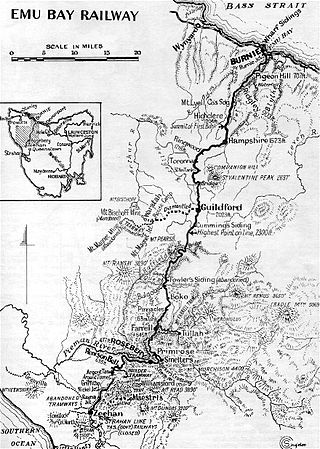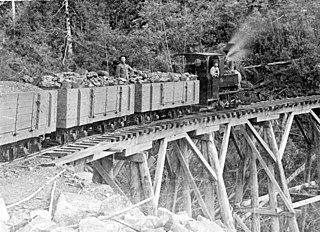| Tasmanian Government Railways E class | |||||||||||||||||||
|---|---|---|---|---|---|---|---|---|---|---|---|---|---|---|---|---|---|---|---|
 | |||||||||||||||||||
| |||||||||||||||||||
| |||||||||||||||||||
| |||||||||||||||||||
| |||||||||||||||||||
The Tasmanian Government Railways E class was a class of 4-6-0T steam locomotives operated by the Tasmanian Main Line Company and later the Tasmanian Government Railways.
| Tasmanian Government Railways E class | |||||||||||||||||||
|---|---|---|---|---|---|---|---|---|---|---|---|---|---|---|---|---|---|---|---|
 | |||||||||||||||||||
| |||||||||||||||||||
| |||||||||||||||||||
| |||||||||||||||||||
| |||||||||||||||||||
The Tasmanian Government Railways E class was a class of 4-6-0T steam locomotives operated by the Tasmanian Main Line Company and later the Tasmanian Government Railways.
In 1874, the Tasmanian Main Line Company took delivery of seven 4-6-0 tank locomotives from the Hunslet Engine Company, Leeds. Problems soon arose with their weight and the side tanks were removed with their water supply carried in a tank in an open wagon that was towed. In 1887, one was sold to the contractor building the Devonport to Ulverstone line and in 1889, another to the builder of the Strahan to Zeehan line. [1] [2] [3]
The remaining five were included in the sale of the Tasmanian Main Line Company to the Tasmanian Government Railways on 1 October 1890 and classified as the E class. Most were converted to 4-4-0 configuration by removing the leading driving axle. The locomotive sold to the Zeehan line contractor was purchased in 1897. From 1907, some were transferred to the Public Works Department. All had been scrapped by 1929. [3]

Dübs & Co. was a locomotive manufacturer in Glasgow, Scotland, founded by Henry Dübs in 1863 and based at the Queens Park Works in Polmadie. In 1903 it amalgamated with two other Glasgow locomotive manufacturers to create the North British Locomotive Company.

The North East Dundas Tramway was a 2 ft narrow gauge tramway, that ran between Zeehan and Deep Lead on the West Coast of Tasmania. Opening in 1896 and closing in 1932, it was part of the Tasmanian Government Railways network. The world's first Garratt locomotives, the K class, were used on the line.

The Tasmanian Government Railways K class was a class of 0-4-0+0-4-0 Garratt locomotives operated by the Tasmanian Government Railways from 1909. They were the first Garratt locomotives built.

The Australian Standard Garratt (ASG) was a Garratt articulated steam locomotive designed and built in Australia during World War II for use on the 1067 mm narrow-gauge railway systems owned by the Australian states of Queensland, South Australia, Tasmania and Western Australia. After the war, ASGs operated in South Australia and at the Fyansford Cement Works railway in Victoria.

The Tasmanian Government Railways (TGR) was the former operator of the mainline railways in Tasmania, Australia. Formed in 1872, the railway company was managed by the Government of Tasmania, and existed until absorption into the Australian National Railways Commission in 1978.

Rail transport in Tasmania consists of a network of narrow gauge track of 1,067 mm reaching virtually all cities and major towns in the island state of Tasmania, Australia. Today, rail services are focused primarily on bulk freight, with no commercial passenger services being operated. The mainline railways of Tasmania are currently operated by TasRail, a Government of Tasmania-owned Corporation, who owns and maintains both rolling stock, locomotives, and track infrastructure.
The Mount Dundas – Zeehan Railway was a railway line running 7 miles (11 km) from Dundas to Zeehan on the West Coast of Tasmania. It operated from 1892 until 1932, and the rails were removed in 1940.

The Richmond Vale Railway was a 4 ft 8+1⁄2 in colliery railway line in the Hunter Valley of New South Wales, Australia, servicing coal mines at Minmi, Stockrington, Pelaw Main and Richmond Main. It was over 26 km (16 mi) long and passed through three tunnels, and was the last commercially operated railway in Australia to use steam locomotives.

The New South Wales Z19 class was a class of 0-6-0 steam locomotives operated by the New South Wales Government Railways of Australia.

The New South Wales AD60 class were Beyer-Garratt patent articulated four-cylinder, simple, non-condensing, coal-fired superheated, 4-8-4+4-8-4 heavy goods steam locomotives built by Beyer, Peacock & Company for the New South Wales Government Railways in Australia.
The Tasmanian Government Railways G class was a class of 0-4-2T steam locomotives operated by the Tasmanian Government Railways.

The Emu Bay Railway was a Tasmania, Australian railway company. The railway was significant during full operation, in that it linked the Tasmanian Government Railways system at Burnie with that at Zeehan that further linked to the Mount Lyell railway allowing connection through to Queenstown.

The South Australian Railways T class was a class of seventy-eight 1067 mm narrow-gauge 4-8-0 steam locomotives operated by the South Australian Railways. Several were sold to the Tasmanian Government Railways; some others operated on the Commonwealth Railways. Four were converted to operate on 1600 mm broad-gauge lines.

The Sandfly Colliery Tramway was a 20 km (12 mi), 2 ft narrow gauge tramway linking the Kaoota Mine to Margate, Tasmania. Constructed in 1905–06, the Tramway climbed 457 m (1,499 ft) above sea level and crossed ten bridges. After coal mining ceased the tramway was used to transport logs, fruit and passengers. The line was lifted and abandoned in 1922 after bushfires destroyed several bridges along the line. Currently, 6 km (3.7 mi) of the old track is used as cycling/walking tracks, while the remainder of the old line is on private property.

The Tasmanian Government Railways A class was a class of 4-4-0 steam locomotives operated by the Tasmanian Government Railways.

The Tasmanian Government Railways B class was a class of 4-4-0 steam locomotives operated by the Tasmanian Government Railways.

The Tasmanian Government Railways C class was a class of 2-6-0 steam locomotives operated by the Tasmanian Government Railways.
The Tasmanian Government Railways H class was a class of 0-4-0WT steam locomotives operated by the Tasmanian Government Railways.

The South Australian Railways O Class (2nd) locomotive was a 4-4-0WT built by Robert Stephenson and Company in 1868 for the Launceston and Western Railway Company. It entered service with the South Australian Railways in 1912 and was cut up in 1930.